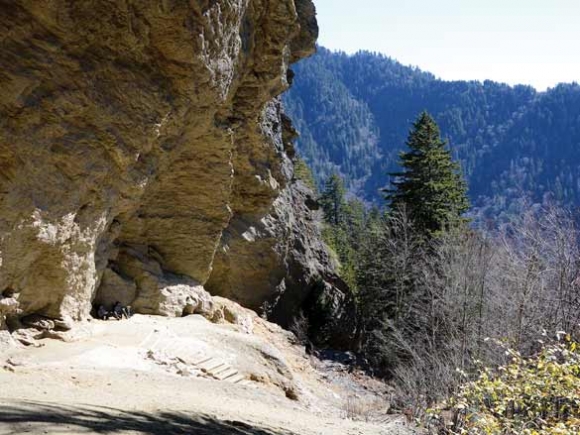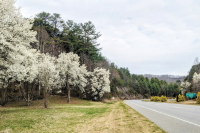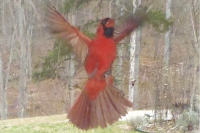To the bluffs: Two-year Alum Cave Trail project culminates

It’s a miraculously warm, blue-skied November day, the iconic Alum Cave Trail stretching smoothly from the trailhead.
The trail invites, almost audibly, framed by a mosaic of rhododendron, leafless deciduous trees and towering hemlocks that have thus far resisted the onslaught of the hemlock wooly adelgid. Tightly constructed wooden bridges and steps interject the trail’s leaf-and-dirt flooring, a stone drainage here and there waiting, shrouded with ferns, to siphon runoff from the trail when the drought finally ends.
It’s everything a trail should be.
And that’s not by accident. Folks hiking the trail that day, Nov. 17, were the first to do so following two years of intensive trail rehabilitation. Before the work began, Alum Cave was a hodgepodge of leaping rocks, eroded edges, unstable steps and braided trails.
It took 50 positions working about 50,000 hours, funded with $500,000 from the Friends of the Smokies Trails Forever endowment to upgrade the popular route to its present state of idyllic tranquility. The trail had to be closed Monday through Thursday, May through October while the work progressed.
With the ribbon cut on the renovated trail, hikers once again have full access. The result is a trail that makes those familiar with what the trail once looked like “ooh” and “ahh,” but it might appear unremarkably normal to a first-time hiker.
Related Items
It’s like building a road, Great Smoky Mountains National Park’s facilities management chief Alan Sumeriski explained to the crowd of about 50 gathered at the ribbon-cutting. If it’s treacherous and rutted and full of potholes, people complain. But if it’s smooth and wide and moves traffic like a road should, nobody really comments.
“That’s the same thing we deal with in trails,” he explained. “When we do it well, people don’t notice it.”
In a way, though, that’s the point. Concentrating less on secure footing means concentrating more on spectacular surroundings.
“It’s not just a rehabilitation of a trail, but it is a transformation of the whole experience, the whole hiking experience,” said Deputy Superintendent Clay Jordan. “Now instead of looking down at your feet trying not to become the next victim hauled out by our park search and rescue team for an ankle, now you look up, look around you, and you embrace the beauty of the Smokies and of the whole experience.”
One of the most popular hikes in the park, the 5-mile Alum Cave Trail was built about 80 years ago by the Civilian Conservation Corps — the crew created as part of FDR’s New Deal that constructed much of the original park infrastructure. In the years intervening, however, the trail had been degraded by heavy use, weather and the simple passage of time. It was heavily eroded, allowing sediment to flow into the nearby Alum Cave Stream. User-made trails had braided around the main route, increasing the trail’s footprint on the surrounding environment. And parts of the trail were downright dangerous, with rocky scrambles and tripping hazards making it a regular destination for the park’s search and rescue team.
All those characteristics — the heavy use, the degradation — made Alum Cave a priority for the Smokies Trails Forever Program, an endowment fund that started when the Knoxville-based Aslan Foundation promised $2 million if Friends of the Smokies could raise an equivalent amount. Friends met that challenge in 2012 to start Trails Forever, and the endowment now holds about $5 million. Since then, the Trails Forever program has rehabilitated the Forney Ridge Trail, the Chimney Tops Trail and now the Alum Cave Trail.
“It really feels good when you start a project with an idea, and less than 10 years later already three major trails have been restored,” Jim Hart, Friends of the Smokies president, said at the ribbon-cutting.
The restoration was sorely needed, but even so, starting the project was not an easy decision, according to the park’s trails program manager Tobias Miller. Alum Cave Trail is immensely popular, and closing it for the two years it would take to do the work would surely inconvenience millions of park visitors. Getting buy-in that the long-term benefits of restoration would outweigh the short-term consequences of closure was the first of many hurdles to cross.
“The most challenging part is just having the vision and convincing everyone of the two-year process to close the trail, to have the long view,” Miller said.
However, Miller said, concerns dissipated as the project got underway.
“Halfway through the first season, everyone was really very excited,” he said.
Rock-breaking and artistic touches
To an outside observer, that excitement might be surprising, because the reality of rebuilding a trail is anything but a walk in the park.
Take, for example, Arch Rock, an unmistakable landmark on the trail. True to its name, Arch Rock is a massive, arched rock sticking out of the mountainside with a hollow center. The trail passes right through it.
Before the rehabilitation, it was “pretty tough” to get through, said Eric Wood of the Trails Forever crew. The rock steps inside were loose, rickety. Passage required a little bit of balance, a little bit of squeezing. It might take about 10 minutes to accomplish.
The last time Steve and Janie Garrison, of Strawberry Plains, Tennessee, hiked Alum Cave, Arch Rock pretty much did them in. They turned around there, at the 1.25-mile mark, rather than pressing on to the view from Alum Cave Bluffs, at 2.5 miles. This day, their experience was much different. They made it through the rock with ease and were confident in their chances of reaching the bluffs.
“They made it so safe,” said Steve, 71. “It was great.”
It’s easy to see that Wood is rather proud of the work that he and his crew did to achieve that result, and it’s no wonder. It took 10 workers five months to finish the section, due mainly to the 74 rock steps they installed in the process.
Each step was made from a rock weighing 300 to 1,500 pounds. Workers first had to find suitable rocks in the forest surrounding Arch Rock, and then they had to move them using ropes and pulleys. Each rock had to be drilled, split using feathers and wedges, and installed with precision. The steps are made using drystone masonry, meaning no mortar is used — mortar can crack and degrade over time, so the drystone method is meant to result in longer-lasting steps.
“I don’t really know what would move these rocks barring an earthquake,” Wood said.
In addition to those 74 rocks destined to become steps, another 140 rocks were installed along the sides to prevent erosion. If the average rock falls in the middle of that 300 to 1,500-pound range, then the Arch Rock section alone involved moving, shaping and installing nearly 200,000 pounds of rock.
“It was quite the project,” Wood said.
Adding to the difficulty is the fact that the goal is a finished product that hides the fact that there was ever a project at all. Rocks must be positioned to hide the drill marks. Any turned-up earth must be restored to its original leaf-littered condition. Trail crews even planted vegetation alongside the newly installed trail infrastructure — nothing makes a rock look like it’s sat stationary for ages more than a cluster of fern fronds growing alongside it.
“We try to make things look as natural as possible,” explained Trails Forever crew leader Josh Shapiro, gesturing toward a rock-walled drainage crossing the trail. “When we walk away from a project, we want it to look like it was here for 50 years.”
The project is all about details — shaping the rock just so, fitting locust logs together without a gap, pulling hand cables tight and installing rocks so that even the feet of 100 million tourists won’t move them.
Or, in the case of the dusty earth at the bluffs, cultivating a trail where before there was nothing but an unmarked expanse of rocky earth.
“There was no defined trail though this area at all,” said Anna Lee Zanetti, North Carolina director for Friends of the Smokies, as she enjoyed lunch at the bluff. It was just unsafe, she said, but now visitors can take in the “epic” view without slipping on rocks and displacing soil. That’s important for park management, and it’s important for visitation.
“This is a hikers’ park,” Zanetti said. “This is really what draws people to us is the hiking opportunities.”
Grooming the CCC 2.0
Even with the work done and the trail open, crew members along for the inaugural hike were busy looking around, testing footholds, wondering how this step or that stone would fare after a good rain.
The general public was a lot less critical.
“I was just amazed, amazed at the work they do,” said Debra Ferrell of Sevierville, who is also a trail guide author. “It’s beautiful.”
Trail construction is artistry as well as engineering, an undertaking that’s markedly different from other types of building and development out there in the world today. So, in addition to the simple goal of building an improved trailbed, the project had a secondary goal as well — to show the next generation of trail builders how it’s done.
Students from the nonprofit American Conservation Experience provided the bulk of the labor for the project, contributing more than 44,000 hours with a rotating roster of workers putting 44 people on the trail at all times. Throughout the season, one crew would stay camped out on Mount LeConte, with another crew camping at the Pigeon Forge KOA and commuting to work on the lower portion of the trail.
It’s vital, Sumeriski said, to keep those specialized skills alive among young people headed to work in the conservation field.
“For us to continue to develop this crew through the efforts of Trails Forever is just phenomenal,” he said.
ACE’s involvement is important beyond the simple preservation of trail building skills, added the organization’s southeastern director Adam Scherm. It also exposes students to a much larger picture of what their professional life could look like.
“They get some of the basic skills and hard skills from working alongside Park Service members, but they also learn some of the bigger picture management techniques just by speaking with the park rangers,” he said.
For all those reasons, Scherm is hoping to bring his crews back to the Smokies next year, when the park will begin rehabilitation of the next trail in the lineup — Rainbow Falls Trail.
Looking at the results of the past two years, while the sun shines and the creek burbles, it’s easy to feel optimistic.
“The trail was built by the CCC 80 years ago, and now we are getting to do kind of a CCC 2.0,” Miller said. “We’re basically refreshing it and hoping for another 100 years that Americans can enjoy these gems. That’s what it is for me. It gives access to the American public to these amazing places.”
Rainbow Falls Trail up next
With the Alum Cave Trail rehabilitation complete, the Great Smoky Mountains National Park is jumping into planning for the next trail project in line under the Smokies Trails Forever Program — the Rainbow Falls Trail.
The 6.5-mile trail, like Alum Cave, is one of the many routes to Mount LeConte. It sees heavy use, and because the lower portion leading to the falls is mostly level, it’s become so heavily braided that it can be hard to even tell where the original trail route should lie.
“We pick the projects based off of what has the most degradation, the most impact, the most use,” explained Tobias Miller, the park’s trails program manager.
Those criteria align closely with the Rainbow Falls Trail’s current state.
Like the Alum Cave project, the Rainbow Falls Trail is expected to take two full seasons to complete. Park staff will spend the winter planning the particulars of the project.
To donate to Smokies Trails Forever, visit friendsofthesmokies.org/product/preserve-trails-forever.
By the numbers
Reconstructing a 5-mile-long trail in a national park with almost no heavy equipment is not an easy task. Hand tools and raw strength were the key ingredients in producing the following results:
• 354 steps totaling 10,000 square feet chiseled out of bedrock
• 1.4 million pounds of hand-crushed rock filling steps
• 108 rock steps
• 285 locust ladder steps
• 106 locust box steps
• 220 square feet of locust wall
• 165 square feet of rock wall
• 264 new drainages
• 270 linear feet of rerouted trail
• 300 feet of inside drainage ditches
• 18 user-created trails eliminated and rehabilitated
• 25 hazard trees cut down
• 5 miles — the entire trail length — brushed back to original trail standards with small roots and rocks removed.













